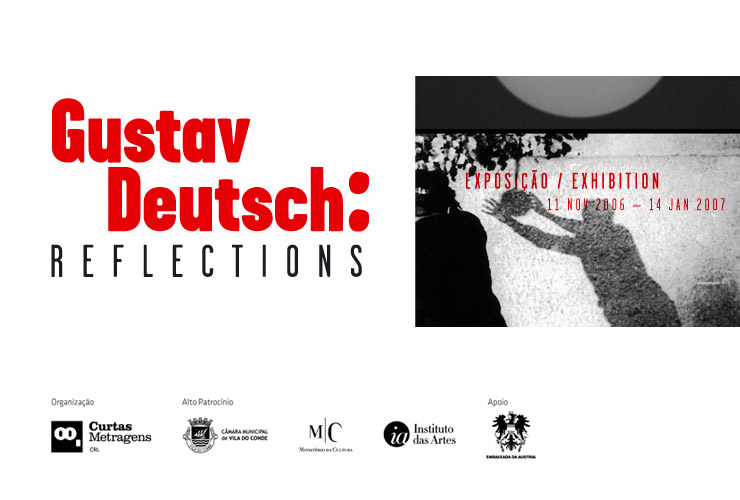EN
REFLECTIONS
Gustav Deutsch
When last August, 18 year old kidnap victim Natascha K. from Vienna managed to escape from captivity in a basement/prison after 8 years and wrote an open letter to the “world public” – as she said herself – and to media representatives, they were surprised by her openness and how well informed she was – she hadn’t been to school since she was 10 years old. When, three weeks after her escape, she made herself available to answer a journalist’s questions in a TV interview, the media were once again surprised at her confident and independent attitude and at the natural way in which she introduced herself to the international media after so many years in isolation.
Apart from her kidnapper, the media – a radio and a newspaper – had been her only sources of information, her only “mirrors and reflexions” of reality beyond her cell. The media had been scanned and censored by her captor: the victim could only listen to one radio programme at a certain time, which was the most prestigious radio station in Austria and she could only read certain newspaper articles, also from the most prestigious Austrian newspaper, that he had previously selected.
One cannot stop thinking – in spite, or precisely because, of the tragedy of this horrible crime – of an event of mythological dimension. What Natascha K. had to experience physically and psychologically comes close to a staging of Plato's Allegory of the Cave: the prisoners in a cave with their eyes fixed in a certain direction and chained since birth have as there only reality the shadows of objects, created by a fire, and projected onto a wall.The objects aremoves by the guards, and the prisioners take their shadows as reality.
The psychiatrist who at Natascha’s request is following her case mentioned that she greeted him as an old acquaintance although she’d never seen him before: she knew him from the media. With the royalties from the sale of her story, Natascha K. wants to create a foundation whose objective is to support the prevention of similar cases, for instance kidnappings, abuse and the serial killings of Mexican women that have been happening in the last 13 years: she learned about this fact through the media.
Besides all the psychological, sociological, socio/political and gender specificgender specific issues raised by this case, there are also questions related to the relevance, function and power of media today. In his famous Allegory of the Cave, Plato foresees a debate about media that continues to this day. Image or reality, illusion or truth – the fundamental issue of the perception and interpretation of our world and in this way also of our existence, has become the central point for the research, invention and creation by generations of artists and scientists. Light and shadow, reflection, mirage and visual phenomena were the themes to which generations of illustrators, painters, photographers and film directors dedicated themselves, as well as doctors, physicists, psychologists and philosophers. I see my work as a director and an audiovisual artist in continuation of this research, these questions and approaches to the fundamental issues of the the perception, recording and interpretation of our world.
REFLECTIONS – The title of this exhibition refers in two ways to the core of my work: the meaning of audiovisual media as a mirror of of the world and the dealingdealing with the phenomena of media themselves. The works to be shown in this exhibition, FILM IST., WELT SPIEGEL KINO, INTERNATIONALER SENDESCHLUSS, emphasizes this orientation already in their titles. All of these three works these have been thought of as a work in progress, as a series of essays for a personal approach to the different forms, types of functioning and effectiveness of optical-acoustic opticamedia – open end. It is not an attempt to formulate a theory or to give answers or definitions, it is about trying to show different approaches to analyse the media, using their own means and, above all, as the director of the Austrian Film Film Museum, Alexander Horwath, wrote in his introduction to FILM IST.(1-6), it is about “casting light on the premonition that no other knowledge generating process is so alive, so open and capable of thought as film.” ODYSSEY TODAY and MARIAGE BLANC are two works dedicated to one of the most important themes of our times and of our world: migration, escape, moving against one’s will, but also mass tourism, meeting the foreignmeeting the foreign, the confrontation with the unknown. In no other time in Man’s evolution has there been, in the physical and virtual world, a bigger gathering of people from different backgrounds, cultures and religions – and this is our opportunity. “The stranger exists when there is in me the conscience of the difference and it stops existing when we all see ourselves as strangers” wrote Julia Kristeva in her book “Fremde sind wir uns selbst” (Strangers to Ourselves). Let us face the mirror provided by the media so that we can become strangers to ourselves.
Gustav Deutsch, October 2006
go back



Solar - Galeria de Arte Cinemática is part of RPAC - Portuguese Network of Contemporary Art

Address
Rua do Lidador, 139
4480-791 Vila do Conde
Rua do Lidador, 139
4480-791 Vila do Conde
Schedule
Monday to Saturday
2:00 pm to 6:30 pm
Closed on Sunday
Monday to Saturday
2:00 pm to 6:30 pm
Closed on Sunday
Contacts
Gallery: solar@curtas.pt
Educational Service: s.educativo@curtas.pt
Press: press@curtas.pt
Office: 252 646 516
Curtas Store: 252 138 191
Gallery: solar@curtas.pt
Educational Service: s.educativo@curtas.pt
Press: press@curtas.pt
Office: 252 646 516
Curtas Store: 252 138 191

